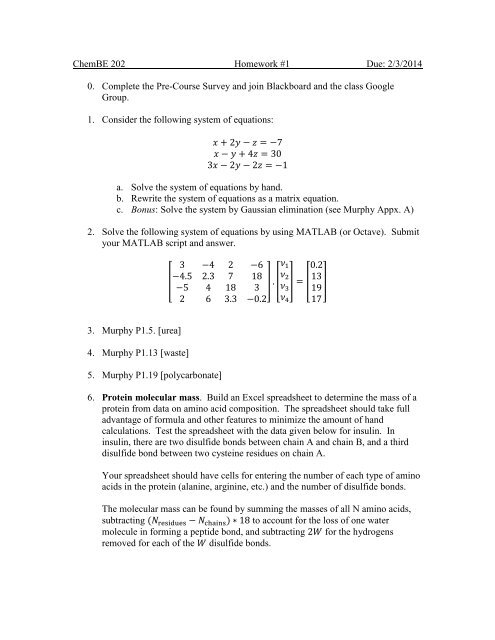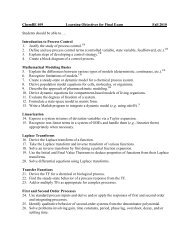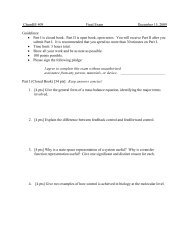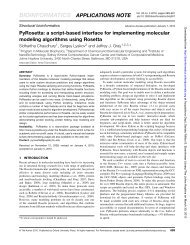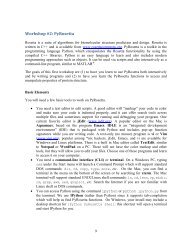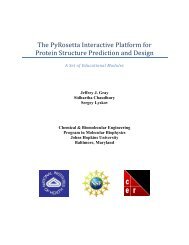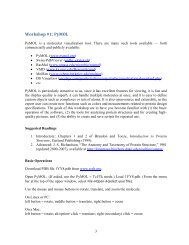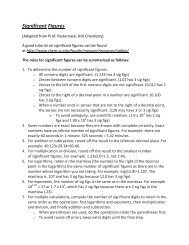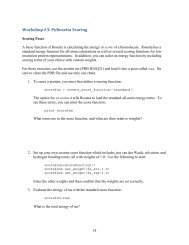ChemBE 202 Homework #1 Due: 9/14/2012 1. Solve the ... - Gray Lab
ChemBE 202 Homework #1 Due: 9/14/2012 1. Solve the ... - Gray Lab
ChemBE 202 Homework #1 Due: 9/14/2012 1. Solve the ... - Gray Lab
Create successful ePaper yourself
Turn your PDF publications into a flip-book with our unique Google optimized e-Paper software.
<strong>ChemBE</strong> <strong>202</strong> <strong>Homework</strong> <strong>#1</strong> <strong>Due</strong>: 2/3/20<strong>14</strong>0. Complete <strong>the</strong> Pre-Course Survey and join Blackboard and <strong>the</strong> class GoogleGroup.<strong>1.</strong> Consider <strong>the</strong> following system of equations:x + 2y − z = −7x − y + 4z = 303x − 2y − 2z = −1a. <strong>Solve</strong> <strong>the</strong> system of equations by hand.b. Rewrite <strong>the</strong> system of equations as a matrix equation.c. Bonus: <strong>Solve</strong> <strong>the</strong> system by Gaussian elimination (see Murphy Appx. A)2. <strong>Solve</strong> <strong>the</strong> following system of equations by using MATLAB (or Octave). Submityour MATLAB script and answer.ν 13 −4 2 −6 0.2−4.5 2.3 7 18 ν 2 13[] . [−5 4 18 3 ν] = [ ]3 192 6 3.3 −0.2 ν 4 173. Murphy P<strong>1.</strong>5. [urea]4. Murphy P<strong>1.</strong>13 [waste]5. Murphy P<strong>1.</strong>19 [polycarbonate]6. Protein molecular mass. Build an Excel spreadsheet to determine <strong>the</strong> mass of aprotein from data on amino acid composition. The spreadsheet should take fulladvantage of formula and o<strong>the</strong>r features to minimize <strong>the</strong> amount of handcalculations. Test <strong>the</strong> spreadsheet with <strong>the</strong> data given below for insulin. Ininsulin, <strong>the</strong>re are two disulfide bonds between chain A and chain B, and a thirddisulfide bond between two cysteine residues on chain A.Your spreadsheet should have cells for entering <strong>the</strong> number of each type of aminoacids in <strong>the</strong> protein (alanine, arginine, etc.) and <strong>the</strong> number of disulfide bonds.The molecular mass can be found by summing <strong>the</strong> masses of all N amino acids,subtracting (N residues − N chains ) ∗ 18 to account for <strong>the</strong> loss of one watermolecule in forming a peptide bond, and subtracting 2W for <strong>the</strong> hydrogensremoved for each of <strong>the</strong> W disulfide bonds.
Bonus: Use special functions in Excel to automatically count <strong>the</strong> number of aminoacids of each type in <strong>the</strong> sequence. Thus, <strong>the</strong> input will simply be <strong>the</strong> sequence ofamino acids (using <strong>the</strong> one-letter code may simplify <strong>the</strong> lookup).Molecular Weight Chain A Chain BAla: 89 <strong>1.</strong> GLY <strong>1.</strong> PHEArg: 174 2. ILE 2. VALAsn: 132 3. VAL 3. ASNAsp: 133 4. GLU 4. GLNCys: 121 5. GLN 5. HISGln: <strong>14</strong>6 6. CYS 6. LEUGlu: <strong>14</strong>7 7. CYS 7. CYSGly: 75 8. THR 8. GLYHis: 155 9. SER 9. ASPIle: 131 10. ILE 10. HISLeu: 131 1<strong>1.</strong> CYS 1<strong>1.</strong> LEULys: <strong>14</strong>6 12. SER 12. VALMet: <strong>14</strong>9 13. LEU 13. GLUPhe: 165 <strong>14</strong>. TYR <strong>14</strong>. ALAPro: 115 15. GLN 15. LEUSer: 105 16. LEU 16. TYRThr: 119 17. GLU 17. LEUTrp: 204 18. ASN 18. VALTyr: 181 19. TYR 19. CYSVal: 117 20. CYS 20. GLY2<strong>1.</strong> ASN 2<strong>1.</strong> GLU22. ARG23. GLY24. PHE25. PHE26. TYR27. THR28. PRO29. LYS30. THR


